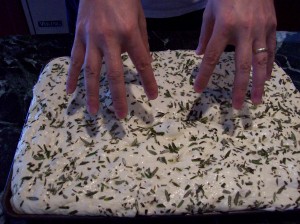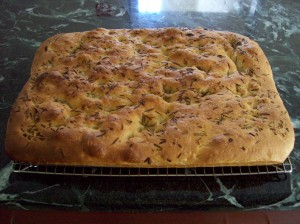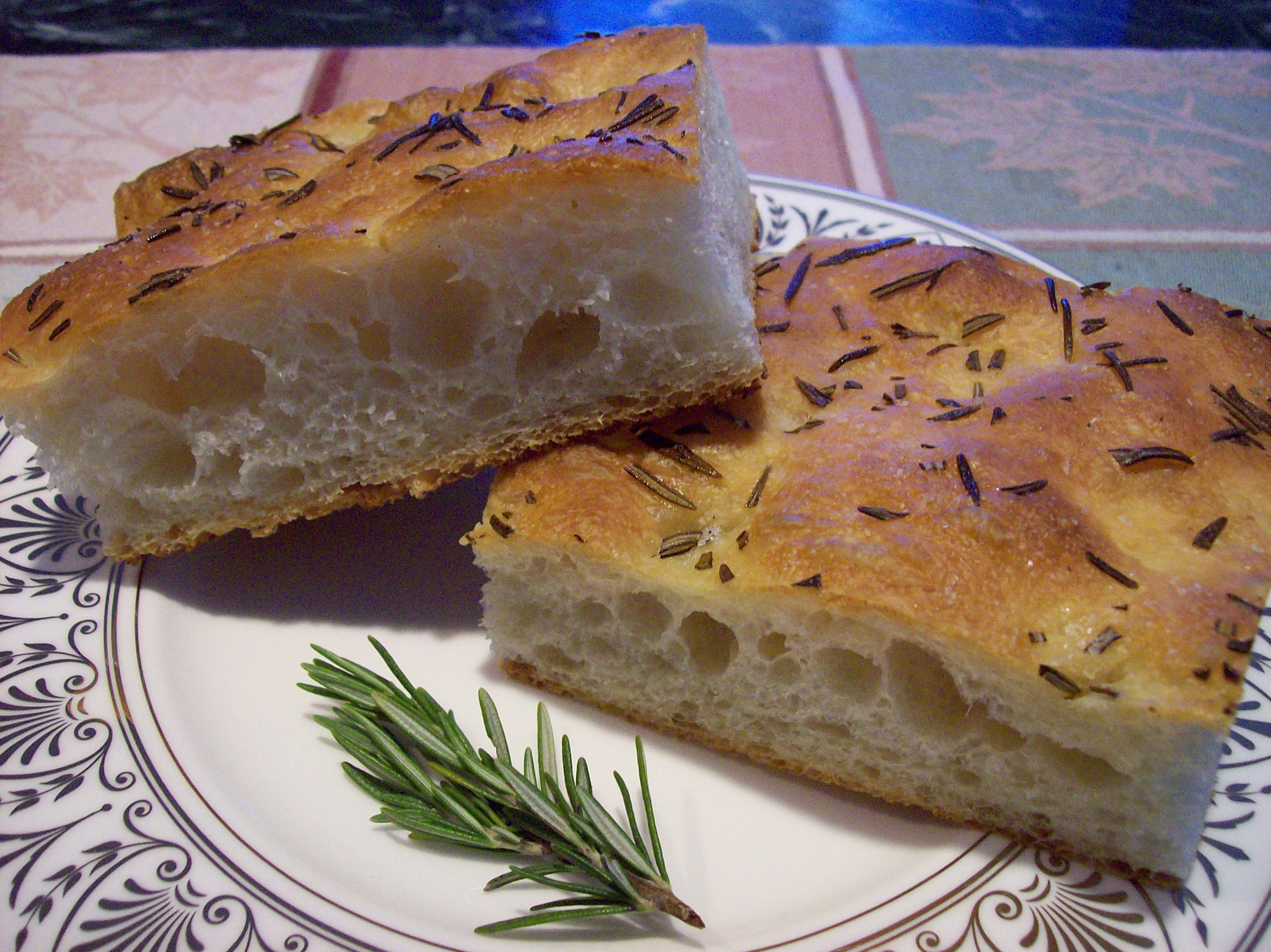Rosemary Focaccia
Aug 24th, 2008 by SteveB
There’s something about focaccia that I can’t quite put my finger on.� People who would�normally just pass around the breadbasket at the dinner table without partaking, lunge hungrily at pieces of focaccia�when included as part of the�breadbasket fare.� Perhaps it’s the delicious unctuousness of the surface craters�filled with fragrant rosemary oil.� Or maybe it’s the light, airy crumb�perfectly suited to sopping up the last�bit of sauce or juice at the end of a perfect meal.��Either way,�focaccia has become a flatbread�favorite here in the U.S., perhaps second only to pizza.
The focaccia formula used here is based on a poolish pre-ferment and is a modified version of the one described in�Reinhart’s�The Bread Baker’s Apprentice.� The focaccia dough is extremely wet (~75% hydration) and contains a fair amount of olive oil, making focaccia dough one of the few doughs that I mix using a stand mixer.� The high hydration also necessitates the use of�multiple folds after mixing to�properly develop the gluten.
Poolish
- 320 g Heartland Mill Organic�All-Purpose Flour
- 340 g�Water
- 1/4 tsp.�Instant Yeast
Final Dough
- 565 g of the above Poolish
- 340 g Heartland Mill Organic All-Purpose Flour
- 170 g Water
- 15 g�Salt
- 1 1/2�tsp. Instant Yeast
- 85 g Olive Oil
- Fresh, coarsely chopped Rosemary and Olive Oil, as needed
- Kosher Salt, to taste
Prepare the poolish the night before�baking by�stirring together the flour, yeast and water until the ingredients in the bowl are well incorporated.� Cover the bowl with plastic wrap and let sit at room temperature until the poolish�becomes bubbly, about 3 hours.� Immediately place the bowl in the refrigerator and let the poolish ferment there overnight.
The next morning, remove the poolish from the refrigerator and let warm to room temperature for 1 hour.� Add the water and poolish to the bowl of a stand mixer and mix on low speed with the whisk attachment until the mixture is homogeneous.��With the whisk still going, add the olive oil and continue mixing until the oil is incorporated.� Switch to the paddle attachment, add the flour, yeast and salt, and mix�on low speed until all the flour is hydrated, about 2-3 minutes.� Increase the speed to medium and mix until low to medium gluten development is achieved, about 5 minutes.
Scrape the extremely fluid dough into an oiled container and let rest for 5 minutes.��Fold the dough, using wet hands to prevent sticking, as shown below:
[qt:http://www.breadcetera.com/wp-content/uploads/2008/08/FocacciaFold1.MOV 500 375]
Let the dough ferment for 1 1/2 hours at room temperature, repeating the dough folding at 30 and 60 minutes. After this first fermentation period, the dough is transferred to an oiled baking sheet and olive oil is brushed onto the surface of the dough. Using fingertips, the dough is then gently eased to the edges of the baking sheet, trying to maintain an even thickness throughout. If the dough becomes too elastic during this step, let the dough rest for 5 minutes, then resume. Sprinkle the surface of the dough with fresh, coarsely chopped rosemary, lightly cover with plastic wrap, and let ferment a second time for 1 1/2 hours. After this time, sprinkle additional olive oil over the surface of the dough, dimple the surface with fingertips, and sprinkle the surface with kosher salt, to taste.

The focaccia is baked in a pre-heated, 450�F oven for 20 minutes, rotating the pan 180� after the first 10 minutes to ensure even baking.� The pan is removed from the oven and the focaccia is removed immediately from the pan and allowed to cool on a cooling rack for at least 20 minutes before cutting into slices.


Dear Steve,
I just made my first batch of focaccia, using the double-hydration method, and it looks and tastes great. The main problem was that it seriously stuck to the oven tray, and much of the bottom crust had to be left behind in prying it off.
I have a pizza stone that has worked very well in making ciabatta, and I’m considering using it the next time I make focaccia. I would divide the dough after the first ferment, spread the two halves onto parchment paper for the second ferment, slide the parchment and dough onto a pizza peel for transfer to the preheated pizza stone, and cook the focaccia in two separate batches.
The three things I worry about for this scheme are that it could be quite messy (I envision olive oil running off the dough and onto the stone), one piece would have an extra 20 minutes in the second ferment, and the parchment paper might stick to the bottom crust and cause even more difficulties than the crust sticking to the pan. Any advice? Have you ever used a pizza stone for focaccia?
Thanks,
Joe
Hi Joe,
If you are finding that your focaccia is sticking to the bottom of your baking sheet, I would suggest a simple solution; use more oil when oiling your baking sheet. Don’t be afraid to coat your baking sheet with a generous layer of oil. Also, be sure to remove the focaccia from the baking sheet immediately after it comes out of the oven, while it is still hot.
Dear Steve,
I was able to acquire a teflon bake pan via the web, and this has solved the sticking problem. I made my second batch of focaccia yesterday, and it came out great without any sticking at all. The top crust is perfect and the crumb is similar to that shown here. The only room for improvement that I can see is that the bottom crust (while tasting fine) did not brown much at all. Might this be due to teflon pan? To get a browner bottom crust, would you suggest a hotter or a cooler oven?
Joe
P.S.
Right after sending my last message, another approach for a browner bottom crust became apparent to me. Since the bread has no tendency to stick at all on the teflon pan, I could easily slide it onto the oven rack or onto a preheated pizza stone half-way through the baking. Does this sound promising?
Joe
Hi Joe,
Removing the focaccia from the pan before the bake is complete and finishing the bake on a hot stone sounds like the way to go.
Sir,
I made this again (The first one didn’t last very long!)
I split the dough into 2 11×7 inch pans. Each pan had a different seasoning. One was the Tuscany seasonng and one was rehydrated Roma tomatoe pieces, Shatake mushroom pieces, garlic and Italian spices.
I did remember the Kosher salt this time. ;>)
I must say that this will be a household standard for some time to come.
Thank you for sharing this recipe.
Deka
Hello there SteveB,
I do like the look of your focaccia, and i would love to try it, however i do have a question:
2. I assume this recipe makes 2 breads, if i wanted to make only one, can i half it?
Hi MrsW,
The recipe is scaled to produce a single, home baking sheet-sized focaccia. That being said, there shouldn’t be any problem with you scaling the recipe to whatever quantity of dough you wish.
Shalom Steve.
Is it possible to make this focaccia with whole wheat?
Avital
Avital שלום
Without meaning to sound snarky, I would say that virtually any bread can be made with just about any flour as long as the baker realizes that the original characteristics of the bread may not be maintained (n.b., bread purists may also insist upon calling the new bread by a different name). If you wish to bake a focaccia using whole wheat flour without changing the essential character of the bread, my personal preference would be to use no more than about 5% whole wheat flour in the formula.
hiya,
i have to say this foccacia recipe is the best so far! thanks for sharing =>
Great recipe. Made a half batch tonight for dinner and cooked it up in one of my rectangular pizza pans. The wife was really happy with the taste and crumb, and such a delicious olive oil flavor throughout. Though I may have gone overboard when panning the dough with the oil. 😉 Thanks again!
I transformed your wonderful recipe into a pizza. No sauce, just some of my favorite fresh herbs, a few veggies and some cheese. I left plenty of “edge” because I figured correctly the add ons would collapse the center. It turned out amazing! The center crust was soft but not soggy and the edge was light as a feather and heavenly. I will be doing this again soon. But maybe next time just opt for the unadorned focaccia. Now that I’ve discovered your great site, I plan on being a regular visitor. Thanks so much!
Steve,
Going to a friends house today and wanted to bring a special treat … of course I thought of your Rosemary Focaccia!
It is in the oven as we speak. Just about to give it it’s half turn and wow does my kitchen smell wonderful. Rosemary, Olive oil and fresh baked bread. Not sure if there is a better combination!
Due to timing issues I had to use bulk fermentation and rising. I let it rise for seven hours in a very cold room (about 55F,) and then shaped the bread and put it in the fridge overnight. Took it out at 6:00am put it in a warm cupboard for two hours for the final rise. (Yes I went back to bed!)
Thanks for sharing it and keeping the blog going!
Cheers,
Tom
Just finished my first bite! It was a long process but absolutely the best bread I have ever made AND the best Focaccia I have ever tasted! Thank you so much for sharing.
Nikole
Wow! This came out amazing. I baked it this afternoon. We used a rosemary/calmetta olive flavored oil along with som sun-dried tomato oilve oil on top. Thanks for the fantastic recipe!
Hi Steve,
I’m just double-checking that you really meant to mix the dough with the wire whisk (whip) attachment. I’ve never seen any recipe suggest mixing the heavy dough with the thin whisk nor, after that, to knead with the paddle. You didn’t mean mix with the paddle and knead with the dough hook? Is there some reason to not use the dough hook at all? I’m just being cautious before proceeding- I don’t want to break my machine!
Thanks,
Zoobee
Hi zoobee,
The wire whisk is used to mix and aerate the initial poolish, water and olive oil mixture. This mixture is quite watery and will not harm your whisk in any way. You’ll note that the whisk is changed to a paddle attachment before any flour is added to the mixture.
Hi Steve, Thanks for your quick response- I am actually waiting for the poolish to come up to room temp right this minute! I read your mixing #2 topic last night and realized you were serious about the whisk! But in that post, you do switch to the hook later. Would you just clarify that in this dough you don’t use the hook at all? I am using a Kitchenaid 600, not a DLX or anything heavy duty- not sure that would be a factor.
zoobee,
The dough hook is not used for the focaccia formula described above.
Thanks!
My first try at Focaccia. My dough was much more liquid than yours. it was difficult to fold it. Not sure why. Made a much thinner bread too. Better luck next time I guess. I don’t have a stand mixer so I used a hand mixer to mix it.
Hi Steve, OMGOODNESS My husband LOVES Focaccia. Cant wait to bake him a loaf or two. Your recipe sounds sooo wonderful, and from all the comments it most likely IS wonderful. My one question, my husband loves Focaccia with a thicksh hard crust and airy inside dough.
Can you give me any hints on how to archive the thick crusty crust??
I will let you know how this comes out when I bake your recipe.
Thank you for a great site.
Hi Carol,
My hints on achieving a thick, crispy crust and open crumb structure? Follow the recipe! 🙂
Steve – late Friday – Sept 2015
Am starting a focaccia dough this afternoon.
I generally use a family recipe from southern Italy (Puglia) and usually start with a biga at 60% hydration.
I’ll try incorporating or adapting your recipe and technique for this batch.
.
My question, however, is this. Our recipe includes the addition of one small/medium potato that’s been peeled, boiled and “riced”/mashed.
Your recipe does not use the potato.
What would you think is the effect adding or omitting the potato on the crumb & crust of the finished focaccia ?
.
Look forward to your comments and opinion. Thanks.
S.S. Strippoli,
I would think that the addition of a small, riced potato would have a minimal effect on the crust and crumb of focaccia made using the recipe in this post (assuming the hydration has been adjusted for the potato), but it could add a subtle nuance to the flavor.